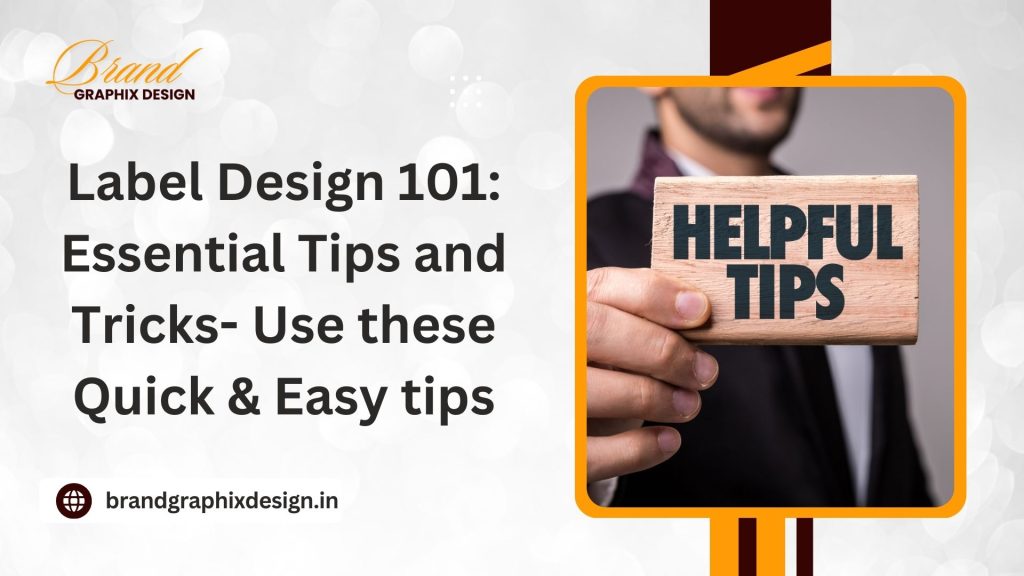In today’s competitive market, the design of your product’s label can make or break its success. A well-crafted label not only grabs attention but also communicates essential information, reflects your brand’s identity, and can even influence purchasing decisions. Whether you are launching a new product or revamping an existing one, mastering the basics of label design is crucial. In this blog, we’ll cover essential tips and tricks for creating effective labels that stand out on the shelf and resonate with your target audience. Let’s dive into Label Design 101!
1. Keep It Simple and Clear
The most important rule in label design is simplicity. Overcomplicating your label with too much information, overly complex graphics, or a cluttered layout can confuse customers and make your product less appealing. A simple, clear design helps convey your message quickly and effectively.
- Focus on Key Information: Only include the most essential details, such as product name, key benefits, and necessary legal information.
- Use Readable Fonts: Choose fonts that are easy to read, even from a distance. Avoid using too many different fonts on the same label.
- Maintain White Space: Don’t overcrowd the label. White space can help important elements stand out and make the label look more organized.
A clear and straightforward label not only looks professional but also ensures that customers can easily understand what your product is all about.
2. Prioritize Brand Consistency
Your label is a reflection of your brand. It should be consistent with the overall branding of your company, including colors, fonts, logos, and messaging. This consistency helps build brand recognition and trust with your customers.
- Use Brand Colors: Incorporate your brand’s primary and secondary colors into the label design. Consistent use of colors across all products strengthens brand identity.
- Feature Your Logo Prominently: Make sure your logo is visible and appropriately sized on the label. It should be easily recognizable.
- Align with Brand Voice: The tone and style of any text on the label should match your brand’s overall voice, whether it’s casual, formal, or playful.
Consistency in label design across your product range helps reinforce your brand and makes your products more recognizable to consumers.
3. Choose the Right Label Material
The material you choose for your label is just as important as the design itself. The right material can enhance the look of your product and ensure that the label stays intact under various conditions. Consider the environment in which your product will be stored and used when selecting a label material.
- Consider Durability: Choose materials that can withstand the conditions your product will face, such as moisture, heat, or cold. Waterproof or heat-resistant materials are great for products like beverages or frozen goods.
- Explore Different Finishes: Matte, glossy, or textured finishes can add a unique touch to your label. A matte finish gives a sophisticated look, while a glossy finish can make colors pop.
- Eco-Friendly Options: If sustainability is a key part of your brand, consider using recyclable or biodegradable materials for your labels.
Choosing the right material ensures that your label not only looks good but also remains durable and functional throughout the product’s lifecycle.
4. Ensure Legibility and Contrast
No matter how attractive your label design is, it won’t be effective if the text is hard to read. Legibility is crucial, and contrast plays a big role in making sure that your text stands out against the background.
- High Contrast Text: Ensure there is a strong contrast between the text and the background. Dark text on a light background, or vice versa, is typically easier to read.
- Font Size Matters: Use a font size that is large enough to be easily readable from a distance. Important information, such as the product name, should be particularly prominent.
- Avoid Busy Backgrounds: If your label has a detailed or colorful background, make sure it doesn’t interfere with the readability of the text. Consider using a solid color block behind the text if necessary.
Good contrast and clear text ensure that customers can quickly read and understand your label, which can lead to better customer engagement and increased sales.
5. Highlight Key Benefits and Features
Customers often make purchasing decisions based on the benefits and features of a product. Highlighting these on your label can help persuade customers to choose your product over a competitor’s.
- Use Bullet Points: List key features or benefits in bullet points to make them stand out and easy to read at a glance.
- Focus on What Sets You Apart: Highlight what makes your product unique, whether it’s an all-natural ingredient, a special formula, or a unique selling point.
- Include Certifications: If your product has certifications, such as organic, non-GMO, or cruelty-free, make sure these are clearly visible on the label.
By emphasizing the key benefits and unique features, your label can serve as a persuasive tool that drives customers to choose your product.
6. Incorporate Eye-Catching Visuals
Visual elements like images, icons, and graphics can greatly enhance your label design. These visuals can quickly convey information and make your product more appealing. However, it’s important to strike the right balance between visuals and text.
- Use Relevant Imagery: Choose images that are relevant to your product and brand. For example, a picture of fresh fruit on a juice label can immediately convey freshness and natural ingredients.
- Icon Use for Clarity: Use icons to represent features or certifications. For instance, a small leaf icon can indicate that a product is eco-friendly.
- Balance Visuals and Text: Ensure that visuals complement the text without overwhelming it. The text should still be the primary focus, with visuals enhancing the overall design.
Effective use of visuals can make your label more attractive and help communicate key information quickly, making your product more appealing to potential buyers.
7. Make Your Label Stand Out on the Shelf
Your label needs to stand out among dozens of other products on the shelf. A unique and eye-catching design can make all the difference in catching a customer’s eye and encouraging them to pick up your product.
- Unique Shapes: Consider using a label shape that is different from the standard rectangle or square. A unique shape can draw attention and give your product a distinctive look.
- Bold Colors: Use bold and vibrant colors that align with your brand and attract attention. Be careful not to overdo it—balance is key.
- Interactive Elements: Incorporate elements like QR codes or peel-back labels that invite customers to engage with your product further.
By making your label visually distinct, you increase the chances of customers noticing your product and choosing it over others.
8. Test Your Label Design
Before finalizing your label design, it’s essential to test it in real-world conditions. This helps you identify any potential issues and make necessary adjustments before the product hits the shelves.
- Conduct User Testing: Get feedback from potential customers to see how they perceive your label. Are they drawn to it? Can they easily find the information they need?
- Check for Durability: Test your labels under various conditions to ensure they hold up well in different environments, such as humidity, heat, or cold.
- Review for Compliance: Double-check that your label meets all legal and regulatory requirements for your product and market.
Testing your label design ensures that it not only looks good but also performs well in the real world, helping you avoid costly mistakes and ensuring customer satisfaction.
9. Keep Up with Trends and Innovations
Label design trends evolve over time, and staying updated with the latest trends can give your product a competitive edge. Whether it’s new printing technologies, materials, or design styles, keeping your labels current can help you stay relevant in the market.
- Embrace Minimalism: The trend towards minimalistic design continues to grow. Clean lines, simple graphics, and plenty of white space can create a modern, sophisticated look.
- Experiment with Textures: Textured labels are becoming popular, adding a tactile element that can enhance the customer experience.
- Interactive Labels: Augmented reality and QR codes are increasingly used to provide customers with a more interactive experience, linking them to videos, websites, or additional product information.
By staying on top of trends and incorporating innovative elements into your label design, you can keep your brand fresh and appealing to customers.
10. Don’t Forget the Back Label
While the front label is crucial for grabbing attention, the back label plays an essential role in providing detailed information. This includes ingredients, instructions, nutritional information, and any legal disclaimers required by law.
- Organize Information Clearly: Use headings, bullet points, and clear sections to make the back label easy to navigate.
- Maintain Consistency: Ensure that the design of the back label complements the front label in terms of style, fonts, and colors.
- Include Contact Information: Make it easy for customers to reach out with questions or comments by including contact details or a customer service number.
The back label is your opportunity to provide valuable information that can help customers make informed decisions, so don’t overlook its importance.
Enhance Your Label Design Today
A well-designed label is a powerful tool that can attract customers, communicate key information, and reinforce your brand identity. By following these essential tips and tricks, you can create labels that not only look great but also perform effectively in the market. If you’re ready to take your label design to the next level, we’re here to help. Contact us today at +91 91189 11171 to start creating labels that truly stand out.



